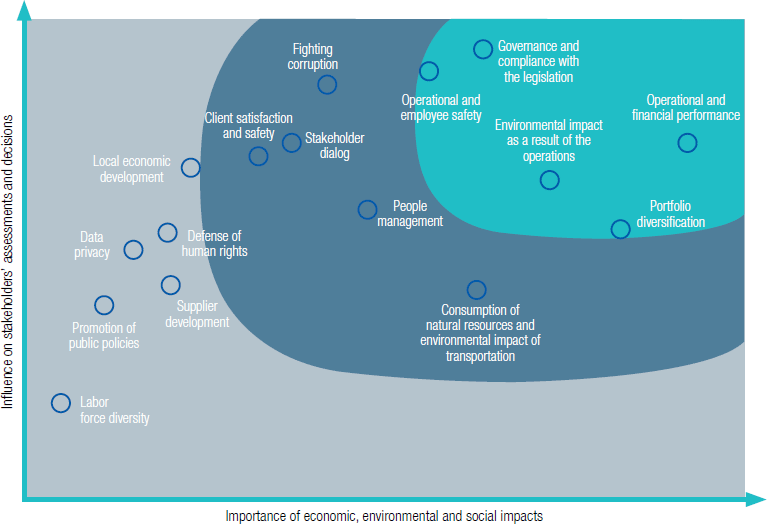Materiality process
GRI G4-18 G4-23Tractebel Energia updated the materiality process during the course of the second half of 2015 to ensure the document is content-relevant, involving the stages proposed under GRI G4 – identification, prioritization and validation and in accordance with the organization’s principal recommendations: context of sustainability, stakeholder inclusiveness, materiality and completeness.
The analysis and definition process developed to prepare the materiality matrix took into account Company and GRI documentation, industry studies and media surveys. An analysis of previous materiality processes of Tractebel Energia and seven on-site panels held in September 2015 as well as online interviews and consultations involving a total of 127 individuals engaged in the process also provided necessary input.
The selection of stakeholders to be consulted took into consideration the process of value creation in the six capitals set out in the Integrated Report guidelines – financial; human; intellectual; manufactured; natural; and social and relationship. In this context, the Company’s regional units and head office both mapped the audience groupings to be engaged, identifying the stakeholders where interaction was greatest. Criteria for selection included the influence of stakeholder groups on the capacity of the Company to generate value as well as its impact on the stakeholders within the scope of each one of the six capitals mentioned above. GRI G4-25
Pursuant to GRI G4 guidance, analyzes were based on the Company’s economic, environmental and social impacts and the potential of each sustainability theme to influence the decisions of the previously-identified stakeholders engaged by Tractebel Energia in the process. GRI G4-24
The principal topics and concerns highlighted by those consulted in the on-site panels were the relevance of energy generation for Brazil; environmental impacts of the generator units (especially in relation to waste and biodiversity); and the socio-economic and cultural impacts on local communities (above all, those arising from the installation of hydroelectric power plants). The way in which these issues are managed is described in the course of this document, topics and concerns being shared with the representatives of the Sustainability Committee, thus facilitating the outlining of action plans and objectives based on such information. Please note, however, that this report does not identify which stakeholder groups raised any given theme. GRI G4-27
Based on this work, the GRI aspects related to material issues and identified in the process for defining report content were: GRI G4-19
| Material Issues | GRI Aspects |
|---|---|
| Financial and operational performance | Economic performance |
| availability and reliability | |
| Demand-size management | |
| Plant decomissioning | |
| System efficiency* | |
| Governance and compliance with the legislation | Compliance (environmental) |
| Unfair competition | |
| Compliance (society) | |
| Marketing communication | |
| Compliance (product responsibility) | |
| Environmental impact due to operations | Emissions |
| Effluent and waste | |
| General (environmental) | |
| Portfolio diversification | Economic performance |
| Research and Development | |
| Operational and employee safety | Disaster/emergency planning and response |
| Occupational health and safety | |
*Refers to the Company’s possible contribution to the efficiency of the National Interconnected System (SIN). |
|
As a result, five themes were deemed of greatest significance – “material” –, five also significant and six in the attention zone as shown in the following graph.

The impacts of the material aspects were then plotted and their limits established as follows: GRI G4-20 G4-21
Material aspects within the organization
Entire Company
- Economic performance
- availability and reliability
- Demand-size management
- Plant decomissioning
- System efficiency
- Research and development
- Conformity (environmental)
- Unfair competition
- Conformity (social – society)
- Marketing communication
- Conformity (social – product responsibility)
- General | environmental
Generator units
- Occupational health and safety
- Disaster/emmergency planning and response
Hydroelectric plants
- Biodiversity
Thermoelectric plants
- Emissions
- Effluents and waste

| Material aspects | External limit |
|---|---|
| Economic performance | |
| Supplier | |
| Government | |
| Investor | |
| availability and reliability | Client |
| Electricity sector | |
| Society | |
| Demand-size management | Client |
| Electricity sector | |
| Society | |
| Plant decomissioning | Community |
| Civil entity | |
| Supplier | |
| Government | |
| System efficiency | Client |
| Electricity sector | |
| Society | |
| Economic performance | Investor |
| Electricity sector | |
| Society | |
| Research and Development | Academy |
| Electricity sector | |
| Society | |
| Compliance (environmental) | Government |
| Sociedade | |
| Unfair competition | Government |
| Electricity sector | |
| Compliance (society) | Government |
| Society | |
| Marketing communication | Client |
| Government | |
| Compliance (product responsibility) | Client |
| Government | |
| Biodiversity | Community |
| Civil entity | |
| Government | |
| Society | |
| Emissions | Community |
| Civil entity | |
| Government | |
| Society | |
| Effluent and waste | Community |
| Civil entity | |
| Government | |
| Society | |
| General (environmental) | Community |
| Civil entity | |
| Government | |
| Society | |
| Occupational health and safety | |
| Supplier | |
| Disaster/emmergency planning and response | Community |
| Civil entity | |
| Supplier | |
| Government | |
| Society | |
Based on the selected criteria and research undertaken, this Report shows the themes deemed as of the greatest relevance to stakeholders and Tractebel Energia in relation to its economic, environmental and social performance.





